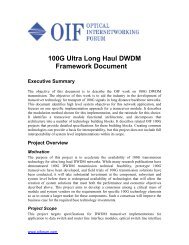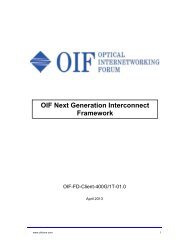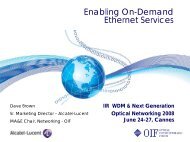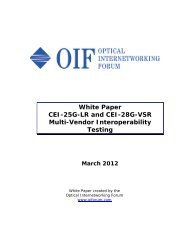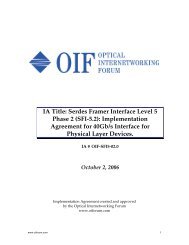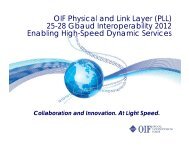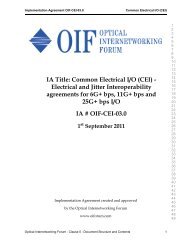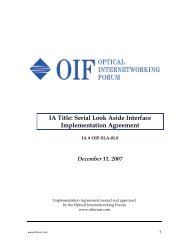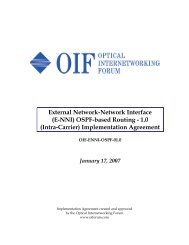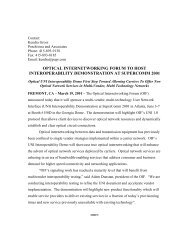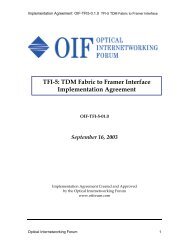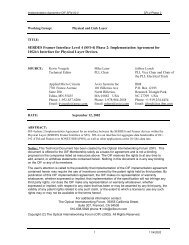White Paper: Multi-Vendor Interoperability Testing of CFP2, CPAK ...
White Paper: Multi-Vendor Interoperability Testing of CFP2, CPAK ...
White Paper: Multi-Vendor Interoperability Testing of CFP2, CPAK ...
Create successful ePaper yourself
Turn your PDF publications into a flip-book with our unique Google optimized e-Paper software.
Table <strong>of</strong> ContentsDEMO PARTICIPANTS AND CONTRIBUTORS: ...............................................................21. EXECUTIVE SUMMARY......................................................................................52. OIF PLL MULTI-VENDOR INTEROPERABILITY TESTING OBJECTIVES.....................92.2 CEI-28G-VSR SPECIFICATION CHANNEL REQUIREMENT .................................102.3 CEI-25G-LR BACKGROUND INFORMATION AND APPLICATIONS .........................113 DEMONSTRATIONS ........................................................................................133.1 DEMO 1: CEI-28G-VSR <strong>CPAK</strong> / <strong>CFP2</strong> 100GBASE-LR4 MODULES ...............133.2 DEMO 2: CEI-28G-VSR <strong>CFP2</strong> 100GBASE-LR4 MODULES............................163.3 DEMO 3: CEI-28G-VSR <strong>CPAK</strong> / <strong>CFP2</strong> 100GBASE-LR4 MODULES ...............193.4 DEMO 4: CEI-28G-VSR <strong>CPAK</strong> / <strong>CFP2</strong> 100GBASE-SR10 MODULES .............213.5 DEMO 5: CEI-28G-VSR QSFP28 ACTIVE COPPER CABLE APPLICATION ..........233.6 DEMO 6: MODULE TO HOST THERMAL INTERFACE MODELING ...........................273.7 DEMO 7: CEI-25G-LR BACKPLANE APPLICATION INTEROPERABILITY ................303.8 DEMO 8: CEI-25G-LR BACKPLANE APPLICATION ............................................323.9 DEMO 9: CEI-25G-LR APPLICATION...............................................................344. CONCLUSIONS...............................................................................................36www.oiforum.com 3
Figure IndexFIGURE 1: CEI-28-VSR REFERENCE MODEL..................................................................... 10FIGURE 2: CEI-28G-VSR REFERENCE MODEL.................................................................. 11FIGURE 3: CEI-28G-VSR CHANNEL RESPONSE ................................................................ 11FIGURE 4: CEI-25G-LR REFERENCE MODEL..................................................................... 12FIGURE 5: DEMO 1 BLOCK DIAGRAM................................................................................. 15FIGURE 6: CISCO / INPHI EVALUATION BOARD .................................................................. 16FIGURE 7: SCREEN CAPTURE FROM XILINX CHIPSCOPE PRO IBERT................................. 16FIGURE 8: DEMO 2 BLOCK DIAGRAM................................................................................. 19FIGURE 9: APPLIED MICRO <strong>CFP2</strong> EVALUATION BOARD .................................................... 19FIGURE 10: DEMO 3 BLOCK DIAGRAM............................................................................... 21FIGURE 11: DEMO 4 BLOCK DIAGRAM............................................................................... 23FIGURE 12: DEMO 5 BLOCK DIAGRAM............................................................................... 27FIGURE 13: MODULE TO HOST THERMAL INTERFACE........................................................ 28FIGURE 14: PERFORMANCE OF DIFFERENT HEAT SINK FIN GEOMETRY ............................ 28FIGURE 15: DEMO 6 - THERMAL PLUGGABLE MODULE ..................................................... 30FIGURE 16: DEMO 7 BLOCK DIAGRAM............................................................................... 32FIGURE 17: DEMO 8 BLOCK DIAGRAM............................................................................... 34FIGURE 18: DEMO 9 BLOCK DIAGRAM............................................................................... 36www.oiforum.com 4
1. Executive SummaryThe Optical Interworking Forum (OIF) is developing a set <strong>of</strong> <strong>Interoperability</strong>Agreements focused on new common electrical interfaces (CEI) applicable tohigher speed optical systems requiring interconnect baud rates <strong>of</strong> 19.60 Gbaudto 28.10 Gbaud using NRZ coding. The OIF is also investigating thestandardization and common understanding <strong>of</strong> thermal performance using acommon set <strong>of</strong> definition metrics in the future. The OIF membership, consisting<strong>of</strong> semiconductor, connector, optical module suppliers, system suppliers, testequipment providers, allows a unique perspective for developing industryrequirements, and a comprehensive understanding <strong>of</strong> the technology trade-<strong>of</strong>fsnecessary to enable the development and support for these requirements.A multi-vendor interoperability event to demonstrate applications <strong>of</strong> CEI-28G-VSR, CEI-25G-LR interfaces and work supporting thermal characterization andstandardization was successfully demonstrated during ECOC 2013 Exhibition byseveral members <strong>of</strong> the OIF Physical and Link Layer (PLL) Working Group. Atthis event, three optical module form factors, namely the Cisco <strong>CPAK</strong>, <strong>CFP2</strong>, andQSFP28, successfully demonstrated support for CEI-28G-VSR interfaces. Thisnew demonstration at ECOC 2013 builds on the previous interoperability eventsthat took place at the OFC 2012, OFC 2013, ECOC 2012 Exhibitions.Also demonstrated were three interoperability demonstrations that support 25Gb/s over backplane per CEI-25G-LR. These three demonstrations used backplane connector systems over various lengths <strong>of</strong> PCB material driven by adaughter card with common quad retimer to show industry support <strong>of</strong> theinterface. These demonstrations were an extension <strong>of</strong> similar ones shown atECOC 2012 and were subsequently documented in a previous white paper.In addition for the first time publicly, OIF members also demonstrated some <strong>of</strong>the work in thermal modeling, in determining some <strong>of</strong> the key metrics that canpotentially be used to support a future standard.In all, the ECOC 2013 PLL interoperability builds on the previous interoperabilityevents and consisted <strong>of</strong> nine individual demonstrations with 13 participatingvendors. The nine demos were assembled as examples that the ecosystem for100Gb/s electrical and optical interfaces is viable and interoperable from multiplesources. It also demonstrated industry cooperation to promote key issues andmetrics for successful implementation <strong>of</strong> next generation communication systemsand networks.1.1 CEI-28G-VSR <strong>Interoperability</strong> <strong>Testing</strong>www.oiforum.com 5
The first four demonstrations exemplified the interoperability <strong>of</strong> pluggableoptics, their electrical interfaces and connectors, retimers and gearbox IC’sthat performed error free over IEEE 802.3ba 100GBASE-LR4 optical links,supporting OTU4 data rates and 100GBASE-SR10 from a variety <strong>of</strong>manufacturers. The four demonstrations were: Demo 1: A Xilinx FPGA using a ChipScope Pro IBERT design driving CEI-28G-VSR to a host card with a Finisar <strong>CFP2</strong> module with integratedSemtech retimer, plugged into it. At the far side <strong>of</strong> the link was Cisco<strong>CPAK</strong> 100GBASE-LR4 module. The modules were optically interoperatingat OTU4 G959.1. The Cisco <strong>CPAK</strong>-100G-LR4 module was driving CEI-28G-VSR into an Inphi 100 GbE gearbox which was looping traffic backthrough the link. A TE Connectivity's <strong>CPAK</strong> connector and cage providethe electrical performance required for the CEI-28G-VSR channel whilealso delivering a mechanical and EMI solution for the Cisco <strong>CPAK</strong>pluggable module. A Tektronix DSA 8300 sampling scope with Tektronix80E10 28Gb/s electrical data eye post S/W CTLE monitoring the eye froma Xilinx FPGA VSR channel. Demo 2: A MoSys breakout board with MoSys gearbox driving CEI-28G-VSR to a host card with a Finisar <strong>CFP2</strong> 100GBASE-LR4 module withintegrated Semtech retimer, plugged into it. At the far side <strong>of</strong> the opticallink was a Fujitsu <strong>CFP2</strong> 100GBASE-LR4 module with an integratedSemtech retimer, both operating at OTU4 G959.1. The Fujitsu <strong>CFP2</strong>module was plugged into an Applied Micro Evaluation board with anAmphenol <strong>CFP2</strong> host connector and was driving CEI-28G-VSR to theApplied Micro 100G Dual rate Gearbox which was looping the traffic backthrough the link. Demo 3: A MoSys breakout board with MoSys gearbox was driving a CEI-28G-VSR channel to a host card with Fujitsu <strong>CFP2</strong> module with integratedSemtech re-timer, plugged into it and at the far side <strong>of</strong> the optical link wasa Cisco <strong>CPAK</strong>-100G-LR4 module plugged into a TE Connectivity <strong>CPAK</strong>connector and cage operating at OTU4 G959.1 driving CEI-28G-VSR intoMoSys breakout board with MoSys gearbox reversing the traffic backthrough the link. Demo 4: An Applied Micro Evaluation board with an Applied Micro 100GDual rate Gearbox was driving a CEI-28G-VSR channel into a Finisar<strong>CFP2</strong> SR10 module and on the far side <strong>of</strong> the optical link was a Cisco<strong>CPAK</strong> SR10 module plugged into TE Connectivity's <strong>CPAK</strong> connector andcage driving the CEI-28G-VSR channel into an Inphi 100 GbE gearboxwhich was generating a data pattern in the reverse direction <strong>of</strong> the link.The fifth demonstration was an example that the infrastructure exists tosupport CEI-28G-VSR channel in other form factors and media. Gearbox IC’s,www.oiforum.com 6
e-timers, host board connectors, and alike supporting zQSFP+ and ActiveCopper cables for short distance interconnects are interoperable betweenvendors. Demo 5: An Inphi 100G Gearbox was driving a CEI-28G-VSR channelthrough a TE Connectivity zQSFP+ host connector assembly to a TEConnectivity 2m QSFP28G Active Copper Cable assembly with integratedSemtech retimers integrated at either end driving CEI-28G-VSR through toa Molex zQSFP+ host connector assembly to an Applied Micro 100GGearbox looping traffic back through the link. An Agilent DCA-X 86100Dwith the 86108B high bandwidth module was used to monitor the electricaleye on the VSR channel.1.2 Thermal ModelingFor next generation systems, the density and data rate <strong>of</strong> interconnects willbe some <strong>of</strong> the critical factors that will determine the success in themarketplace. As such, system designers will continue to push the limits <strong>of</strong> thetechnology to drive capacity and density higher. This, in turn, will alsoincrease the density <strong>of</strong> components to the limits <strong>of</strong> thermal management.Thermal management can limit the performance and reliability <strong>of</strong> acomponent or subsystem and affect the overall integrity <strong>of</strong> the system itself.The intent <strong>of</strong> the OIF is to develop a document that will provide a degree <strong>of</strong>standardization and common understanding across the Networking Industryto enable optimized thermal performance using a common set <strong>of</strong> definitions inthe future. The next demonstration highlights the effect <strong>of</strong> these factor’s onthermal management.Demo 6: Molex and TE Connectivity with a thermal emulator test vehicle,a line card thermal emulator test platform that consists <strong>of</strong> a simulated linecard supporting 8 positions <strong>of</strong> the proposed CDFP 400Gb/s opticalmodules. Module heat dissipation and airflow were controlled andtemperature was measured at various points to detect the effect <strong>of</strong> thesurface roughness and heat sink material. Thermal efficiency wasimproved with smoother surfaces.1.3 CEI-25G-LR <strong>Interoperability</strong> <strong>Testing</strong>The OIF has been at the forefront <strong>of</strong> the industry with the development <strong>of</strong>common electrical interface (CEI) implementation agreements (IA) thatsupport 25 Gb/s over backplane architectures (CEI-25G-LR). Thisdevelopment work is important in enabling the industry to re-use conventionalchassis, line card, backplane and cabling architectures as they developequipment that is able to meet the evolving and challenging bandwidthdemands <strong>of</strong> the communications industry. The next 3 demonstrations areexamples <strong>of</strong> continuing industry support <strong>of</strong> the standards by developing newwww.oiforum.com 7
products. These standards were initially demonstrated at ECOC 2012 andwere documented in an earlier white paper (Frlan 2012).The demonstrations are: Demo 7: MoSys retimer evaluation board driving 4 lanes <strong>of</strong> CEI-25G-LRthrough an Amphenol supplied reference backplane channel consisting <strong>of</strong>two 7 inch daughter cards, a 12 inch long backplane, and two XcededPlusconnectors terminated by a MoSys retimer operating at 25.78125 Gb/serror free with a PRBS 2 -31 (BER
2. OIF PLL <strong>Multi</strong>-<strong>Vendor</strong> <strong>Interoperability</strong> <strong>Testing</strong> Objectives<strong>Interoperability</strong> is one <strong>of</strong> the keys to the success <strong>of</strong> any standard orimplementation agreement. In order to promote the acceptance anddemonstrate the viability <strong>of</strong> CEI-28G-VSR and CEI-25G-LR, the OIFsponsored a private, closed door interoperability Plugfest in August 2013.This Plugfest reiterated that CEI-28G-VSR and CEI-25G-LR are widelysupported by an increasing number <strong>of</strong> companies across the industry withparticipants including five semiconductor manufacturers (Applied Micro, Inphi,MoSys, Semtech, and Xilinx), three connector vendors (Amphenol, Molex, TEConnectivity), three manufacturers <strong>of</strong> optical modules (Cisco Systems, Finisarand Fujitsu Optical Components ) and two test equipment manufacturers(Agilent and Tektronix). Cooperation between semiconductor, connector,optical module, optical component and test equipment suppliers is crucial toenable implementation and integration <strong>of</strong> high-speed signaling by system andoperator vendors. ECOC 2013 showcased working demonstrations <strong>of</strong> theCEI-28G-VSR electrical interface implemented on a Cisco <strong>CPAK</strong> 100GBASE-LR4, Cisco <strong>CPAK</strong> 100GBASE-SR10, <strong>CFP2</strong> 100GBASE-LR4 and <strong>CFP2</strong>100GBASE-SR10 optical modules and a zQSFP28 Active Copper Cable anddemonstrations that addressed the 19.90-25.80 Gbaud CEI-25G-LR interfacefor backplane applications, using test scenarios similar to the privateinteroperability tests.2.1 CEI-28G-VSR, CEI-25G-LR Background Information and ApplicationsThe communications and networking industries' data rates have been increasingalong with the demands for higher levels <strong>of</strong> traffic aggregation. Additionally, theindustry desires interoperable interfaces that support these next generation datarates. The OIF has been at the forefront <strong>of</strong> this demand, leading the industry withthe development <strong>of</strong> CEI implementation agreements (IA) that support up to• 28.10 GBd in chip-to-module electrical interface applications• 25 GBd line card to line card “long reach” electrical interface applications• Thermal interfaces in module to host applicationsThis development work is unique and timely in enabling the industry to re-useconventional chassis and line-cards as they develop equipment that is able tomeet the evolving and challenging bandwidth demands <strong>of</strong> the communicationsindustry. The CEI-28G-VSR Clause is in the final development phase. Theimplementation agreement is expected to be published by the end <strong>of</strong> 2013. TheCEI-25G-LR Clause is ratified and available for industry use.The use <strong>of</strong> pluggable optical transceivers and direct attach copper cables is acommon practice in equipment developed for the communications market.Developing interoperable pluggable solutions that keeps up with the demandingwww.oiforum.com 9
andwidth needs <strong>of</strong> industry is critical to enabling next generation equipment thatsupports the communications service providers.2.2 CEI‐28G‐VSR Specification Channel RequirementThe CEI-28G-VSR application reference diagram is shown in Figure 1. It consists<strong>of</strong> 100Ω differential PCB traces, vias, one connector and AC coupling capacitors.The CEI-28G-VSR IA is intended to be used for “Very Short Reach” channels,with length up to 150 mm, and loss up to 10.0 dB loss at Nyquist rate. The modelthat is being initially targeted for the next generation <strong>of</strong> optical modules is retimedinterfaces operating at 25.78 – 28.10 GBd. The overall CEI-28G-VSR link needsto operate with a bit error ratio (BER) <strong>of</strong> 1e-15 or less. VSR interface supportsmultiple lanes and is hot pluggable.Figure 1: CEI-28-VSR Reference ModelA VSR link supports a maximum loss <strong>of</strong> 10 dB at Nyquist for operation from19.60 to 28.10 GBd with NRZ modulation. The link loss budget is divided into amaximum host PCB loss <strong>of</strong> 7.3 dB, a connector loss <strong>of</strong> 1.2 dB and a module PCBloss <strong>of</strong> 1.5 dB, Figure 2 shows a diagram <strong>of</strong> the loss breakdown. TP1a and TP4aare respectively the host electrical output and input measurement pointsmeasured with Host Compliance Board (HCB) with PCB loss <strong>of</strong> 2.0 dB. TP1 andTP4 are respectively the module electrical input and output measurement pointsmeasured with module compliance board (MCB) with PCB loss <strong>of</strong> 1.25 dB.www.oiforum.com 10
Figure 2: CEI-28G-VSR Reference ModelFigure 3, shows the CEI-28G-VSR channel response scaled for operation at 28GBd with loss <strong>of</strong> 10 dB at Nyquist frequency <strong>of</strong> 14 GHz.0‐3‐6‐9SDD21 (dB)‐12‐15VSR IL‐18‐21‐240 2 4 6 8 10 12 14 16 18 20 22 24 26 28Frequency (GHz)Figure 3: CEI-28G-VSR Channel Response2.3 CEI‐25G‐LR Background Information and ApplicationsAs the demands on industry data rates have increased along with thedemands for higher levels <strong>of</strong> traffic aggregation, the communications andnetworking industries have need <strong>of</strong> interoperable interfaces that supportthese next generation data rates. The OIF has been at the forefront <strong>of</strong> thisdemand by leading the industry with the development <strong>of</strong> common electricalinterface (CEI) implementation agreements (IA) that support 25 Gb/s overbackplane architectures, 28 Gb/s in chip-to-chip applications and 28 Gb/s inwww.oiforum.com 11
chip-to-module applications. This development work is important in enablingthe industry to re-use conventional chassis, line card and cablingarchitectures as they develop equipment that is able to meet the evolvingand challenging bandwidth demands <strong>of</strong> the communications industry.CEI-25G-LR is a recent OIF Clause which address the needs <strong>of</strong> 25 Gb/sLong Reach backplane applications. The CEI-25G-LR Clause was recentlyratified along with CEI-28G-SR as part <strong>of</strong> the Common Electrical I/O (CEI)3.0 Implementation Agreement. The CEI-28G-VSR Clause is underdevelopment and is expected to be ratified later this year.Figure 4: CEI-25G-LR Reference ModelAs shown in Figure 4, backplane architectures are commonly used incommunications equipment. Developing 25 Gb/s backplane channelspecifications is important to enable the industry to continue use <strong>of</strong> thisarchitecture in switches, routers, transport and data center equipment. TheCEI-25G-LR channel consists <strong>of</strong> 100Ω differential PCB traces, vias and upto two connectors. As this IA is targeted to longer reach backplaneapplications total allowable channel loss can be up to 25 dB at Nyquist rateand the transmitter is able to generate a maximum swing <strong>of</strong> 1200 mVppdand is required to have an FIR equalizer. The receiver implementation is notmandated and can be vendor specific.www.oiforum.com 12
3 Demonstrations3.1 Demo 1: CEI-28G-VSR <strong>CPAK</strong> / <strong>CFP2</strong> 100GBASE-LR4 ModulesSupported by: Cisco, Finisar, Inphi, Semtech, TE Connectivity, Tektronix, Xilinx3.1.1 Component OverviewCisco <strong>CPAK</strong> Module: The Cisco <strong>CPAK</strong> 100GBASE-LR4 module (<strong>CPAK</strong>-100G-LR4) is IEEE 802.3ba compliant and supports link lengths <strong>of</strong> up to 10 km overstandard single-mode fiber (SMF, G.652). The module delivers an aggregatebandwidth <strong>of</strong> 100 gigabits per second, carried over four LAN wavelength-divisionmultiplexing (WDM) wavelengths operating at a nominal 25 Gbps per lane. Themodule utilizes Cisco’s advanced complementary metal-oxide semiconductor(CMOS) photonic technology to provide industry-leading optical integration,performance, low power consumption, and scalability. It is compatible with other100GBASE-LR4 compliant modules such as CFP, to support high-bandwidth100-Gb optical links over standard single-mode fiber terminated with SCconnectors. Nominal power consumption is less than 5.5WFinisar <strong>CFP2</strong> Module: Finisar <strong>CFP2</strong> 100GBASE-LR4 modules use a quad 28GDFB DML PIC (Photonic Integrated Circuit) TOSA and quad 28G PIN PIC ROSA,with four 2x28G Semtech CDRs. This results in nominal 6 W total module powerdissipation, and a significantly reduced cost structure compared to Gen1 28GEML TOSA technology.Inphi Gearbox: The Inphi IN112510-LD is a single-chip, low-power tri-rate CMOSPHY for 10:4 gearbox/10:10 retimer applications in 10/40G/100G Ethernet andOTU4 line cards and optical modules. Optimized for low-latency operation, itdelivers high system performance and ultra-low jitter for demanding applications.It is designed to significantly exceed CEI-28G-VSR requirements and allows realtimemonitoring <strong>of</strong> link margin and protocol checking as well as dynamic highresolution eye scan diagnostics.MoSys Gearbox: The MoSys LineSpeed 100G <strong>Multi</strong>-Mode Gearbox IC(MSH310) is a single-chip, low-power CMOS device designed to support 10:4gearbox or 10:10 retiming applications for 10G, 40G and 100G Ethernet andOTU4 line cards and optical modules. The device features a strong self-adaptingequalizer for extended reach on both the 10G and 25G lanes and supportsstandards ranging from CEI-28G-VSR to CEI-25G-LR. The device includes onchipPRBS generation, error checking and diagnostic capabilities.Semtech Retimers: Leveraging a generation <strong>of</strong> innovation in 10G module CDRs,Semtech's GN2425 and GN2426 are low-power retimers optimized for referencefree25-28Gbps operation in next-generation optical modules and active cables.www.oiforum.com 13
By resetting the jitter budgets within the module in both directions, Semtech’sCDRs are perfect for challenging new applications such as 100GBASE-LR4/ER4and OTU4 <strong>CFP2</strong> optical modules. The GN2425 and GN2426 feature best-inclassreceive sensitivity, input jitter tolerance and output jitter, allowing for reliablesignal recovery and clean, wide-open transmit eyes.TE Connectivity Connectors: TE Connectivity's <strong>CPAK</strong> connector and cageprovide the electrical performance required for the CEI-28G-VSR channel whilealso delivering a mechanical and EMI solution for the Cisco <strong>CPAK</strong> pluggablemodule. The connector uses conventional stamped and formed designtechniques combined with shielding methods to deliver a 28Gb/s low noisesolution. The same connector supports both 100G BASE-LR4 and 100G BASE-SR10 applications. The <strong>CPAK</strong> cage provides a riding heat sink design for thermalmanagement and fully integrated EMI and mechanical support features. Theconnector and cage can be applied in both single sided and belly to belly 28Gb/sinstallations.Xilinx FPGA: The Xilinx 7 Series HT family <strong>of</strong> FPGAs utilize heterogeneousstacked 3D IC device integrating both FPGA slices and high performance 25-28.05 GBd transceivers via a silicon interposer. The FPGA slices, implementedon a 28nm high-performance/low-power (HPL) process, contains 580,480 logiccells, 1,680 DSP slices, 33,840Kbits <strong>of</strong> block RAM (BRAM), 48x 13.1 GBd GTHtransceivers and 8x 28.05 GBd GTZ transceivers. The GTZ transceivers aredesigned to exceed the OIF-28G-VSR electrical specification and are targetedspecifically to interoperate with <strong>CFP2</strong> optical modules and are arranged todirectly connect to <strong>CFP2</strong> connectors. For the demonstration, the device has beenconfigured with a ChipScope Pro IBERT design where the device issimultaneously transmitting and receiving PRBS-31 and checking the receiveddata for errors.3.1.2 Demo 1 DescriptionThis demonstration system consists <strong>of</strong> the following blocks: Xilinx FPGA,evaluation board with a <strong>CFP2</strong> connector and cage system, a Finisar <strong>CFP2</strong>100GBASE-LR4 module with integrated Semtech retimer IC, a Cisco <strong>CPAK</strong>100GBASE-LR4 module with integrated retimer IC, and an Inphi 100G gearboxand evaluation board with a TE <strong>CPAK</strong> connector and cage. A PRBS31 datapattern is generated from the Xilinx FPGA across for lanes at 27.95 Gb/s perlane to meet OTN requirements. 100G Ethernet rates at 4x25.78 is alsosupported by the devices in this demonstration. The Xilinx FPGA is connected tothe Semtech Retimer IC inside the Finisar <strong>CFP2</strong> 100GBASE-LR4 module via theCEI-28G-VSR interface across the evaluation board representing approximately8dB <strong>of</strong> loss. The Tx and Rx inputs on the Xilinx FPGA and Semtech retimer aresufficient to ensure error free operation in both directions to the CEI-28G-VSRelectrical requirement. The Finisar <strong>CFP2</strong> 100GBASE-LR4 optical modulewww.oiforum.com 14
transmits and receives the data to the Cisco <strong>CPAK</strong> 100GBASE-LR4 opticalmodule over 10km <strong>of</strong> single mode fiber. The Cisco <strong>CPAK</strong> 100GBASE-LR4module with its integrated retimer from is then connected electrically to an Inphigearbox on the Cisco <strong>CPAK</strong>/Inphi evaluation board (Figure 6) with a CEI-28G-VSR channel connecting the retimer to gearbox. Similarly, PRBS 31 traffic isgenerated in the other direction from the Inphi gearbox following the return path<strong>of</strong> 10km <strong>of</strong> fiber between the Cisco <strong>CPAK</strong> 100GBASE-LR4 module and Finisar<strong>CFP2</strong> LR4 modules and terminating at the Xilinx FPGA. Data integrity ismonitored by the Xilinx FPGA and Inphi gearbox device to ensure error freeoperation and data integrity over extended time (>8 Hours) to conform to theIEEE and OIF standards. Figure 7 is a screen capture from the Xilinx ChipScopePro IBERT indicating error free operation on channels 0 through 3 <strong>of</strong> the100GBASE-LR4 link taken at the PlugFest. The combination <strong>of</strong> Cisco <strong>CPAK</strong> and<strong>CFP2</strong> 100GBASE-LR4 modules from Cisco and Finisar and electricalcomponents from Xilinx, Inphi and Semtech, show extensive industryinteroperability across both optical and electrical interfaces required to meet bothEthernet and OTN standards.Figure 5: Demo 1 Block Diagramwww.oiforum.com 15
Figure 6: Cisco / Inphi Evaluation BoardFigure 7: Screen Capture from Xilinx ChipScope Pro IBERT3.2 Demo 2: CEI-28G-VSR <strong>CFP2</strong> 100GBASE-LR4 ModulesSupported by: Amphenol, Applied Micro, Finisar, Fujitsu, MoSys, Semtech3.2.1 Component OverviewAmphenol <strong>CFP2</strong> Connector: The Amphenol <strong>CFP2</strong> connector designed for OpticalModules running at speeds greater then 10Gb/s up to 25Gb/s per lane. Themodule electrical interface has been generically specified to allow for supplierspecificcustomization around various “4 x 10 Gbit/s” interfaces, but can supportup to 8 x 25 Gbit/s or 4 x 25 Gbit/s electrical interface configurations. Theupcoming CFP4 will use the same technology but reduce the number <strong>of</strong> lanes to4 x 28Gb/s lanes, giving more than twice density for 100Gb/s.Applied Micro Gearbox IC: The S28110PRI Gearbox II from Applied Micro is afully integrated bidirectional 10:4 mux/demux and 10:10 retimer for 100Gbps,www.oiforum.com 16
40Gbps and 10Gbps interconnect applications. It operates at both Ethernet andOTN rates while <strong>of</strong>fering industry leading transmit jitter performance and receivesensitivity. It comes with a host <strong>of</strong> diagnostic features such as receiver eyemonitors, PRBS mon/gen, and virtual lane identification. It is compliant with theOIF-28G-VSR and OIF-28G-SR specifications on the 28Gbps interface whilecarrying an industrial temperature rating.Finisar <strong>CFP2</strong> Module: Finisar <strong>CFP2</strong> 100GBASE-LR4 modules use a quad 28GDFB DML PIC (Photonic Integrated Circuit) TOSA and quad 28G PIN PIC ROSA,with four 2x28G Semtech CDRs. This results in nominal 6 W total module powerdissipation, and a significantly reduced cost structure compared to Gen1 28GEML TOSA technology.Fujitsu <strong>CFP2</strong> Module: The FOC (Fujitsu Optical Components) <strong>CFP2</strong> 100GBASE-LR4 module operating at OTU4 data rates is IEEE 802.3ba and OTU4 G.959.1compliant. The module realizes transmitter good eye performance and receiverhigh sensitivity utilizing 4ch 28G integrated TOSA and 4ch 28G integratedROSA.MoSys Gearbox: The MoSys LineSpeed 100G <strong>Multi</strong>-Mode Gearbox IC(MSH310 ) is a single-chip, low-power CMOS device designed to support 10:4gearbox or 10:10 retiming applications for 10G, 40G and 100G Ethernet andOTU4 line cards and optical modules. The device features a strong self-adaptingequalizer for extended reach on both the 10G and 25G lanes and supportsstandards ranging from CEI-28G-VSR to CEI-25G-LR. The device includes onchipPRBS generation, error checking and diagnostic capabilities.Semtech Retimers: Leveraging a generation <strong>of</strong> innovation in 10G module CDRs,Semtech's GN2425 and GN2426 are low-power retimers optimized for referencefree25-28Gbps operation in next-generation optical modules and active cables.By resetting the jitter budgets within the module in both directions, Semtech’sCDRs are perfect for challenging new applications such as 100GBASE-LR4/ER4and OTU4 <strong>CFP2</strong> optical modules. The GN2425 and GN2426 feature best-inclassreceive sensitivity, input jitter tolerance and output jitter, allowing for reliablesignal recovery and clean, wide-open transmit eyes.3.2.2 Test Equipment OverviewTest equipment supplied to the PLL Interop demonstration by Tektronix includesthe following:DSA8300 Sampling Oscilloscope: The DSA8300 Series is a modularoscilloscope system that allows for electrical and optical sampling modules. Forthe OIF Interop, Tektronix provides the 80E10B Electrical Module. When usedwith the DSA8300 Series, this new module provides sub-100 femtosecondintrinsic jitter, low vertical noise, >45GHz bandwidth performance to enable highwww.oiforum.com 17
fidelity measurements <strong>of</strong> OIF 28G-VSR system.3.2.3 Demo 2 descriptionThis demonstration system consists <strong>of</strong> the following blocks: a MoSys gearbox,evaluation board and <strong>CFP2</strong> breakout board, a Finisar <strong>CFP2</strong> LR4 module withintegrated Semtech retimer IC, a Fujitsu <strong>CFP2</strong> LR4 module with integratedSemtech retimer IC, and an Applied Micro 100G gearbox and evaluation boardwith the Amphenol <strong>CFP2</strong> connector. A PRBS31 data pattern is generated fromthe gearbox device across for lanes at 27.95 Gb/s per lane to meet OTNrequirements. 100G Ethernet rates at 4x25.78 is also supported by the devices inthis demonstration. The MoSys gearbox is connected to the Semtech Retimer ICinside the Finisar <strong>CFP2</strong> LR4 module via an evaluation board and breakout boardrepresenting approximately 8dB <strong>of</strong> loss. The Tx and Rx inputs on the MoSysgearbox and Semtech retimer are sufficient to ensure error free operation in bothdirections to the CEI-28G-VSR electrical requirement. The Finisar <strong>CFP2</strong> LR4optical module transmits and receives the data to the Fujitsu <strong>CFP2</strong> LR4 opticalmodule over 10km <strong>of</strong> single mode fiber. The Fujitsu module with its integratedretimer from Semtech is then connected electrically through the Amphenol <strong>CFP2</strong>connector to an Applied Micro gearbox through using an integrated breakoutboard with a CEI-28G-VSR channel connecting the retimer to gearbox. Similarly,PRBS 31 traffic is generated in the other direction from the Applied Microgearbox following the return path <strong>of</strong> 10km <strong>of</strong> fiber between the Fujitsu <strong>CFP2</strong> andFinisar <strong>CFP2</strong> LR4 modules and terminating at the MoSys gearbox. Data integrityis monitored by both gearbox devices to ensure error free operation and dataintegrity over extended time (>8 Hours) to conform to the IEEE and OIFstandards. The combination <strong>of</strong> <strong>CFP2</strong> LR4 modules from Finisar and Fujitsu andelectrical components from Applied Micro, MoSys and Semtech, show extensiveindustry interoperability across both optical and electrical interfaces required tomeet both Ethernet and OTN standards.www.oiforum.com 18
Figure 8: Demo 2 Block DiagramFigure 9: Applied Micro <strong>CFP2</strong> Evaluation Board3.3 Demo 3: CEI-28G-VSR <strong>CPAK</strong> / <strong>CFP2</strong> 100GBASE-LR4 ModulesSupported by: Cisco, Fujitsu, MoSys, Semtech, TE Connectivity3.3.1 Component OverviewCisco <strong>CPAK</strong> Module: The Cisco <strong>CPAK</strong> 100GBASE-LR4 module (<strong>CPAK</strong>-100G-LR4) is IEEE 802.3ba compliant and supports link lengths <strong>of</strong> up to 10 km overstandard single-mode fiber (SMF, G.652). Currently in production, it delivers anaggregate bandwidth <strong>of</strong> 100 gigabits per second, carried over four LANwavelength-division multiplexing (LAN-WDM) wavelengths operating at anominal 25 Gbps per lane. The module utilizes Cisco’s advancedcomplementary metal-oxide semiconductor (CMOS) photonic technology toprovide industry-leading optical integration, performance, low powerconsumption, and scalability. It is compatible with other 100GBASE-LR4www.oiforum.com 19
compliant modules such as CFP, to support high-bandwidth 100-Gb optical linksover standard single-mode fiber terminated with SC connectors. Nominal powerconsumption is less than 5.5WFujitsu <strong>CFP2</strong> Module: The FOC (Fujitsu Optical Components) <strong>CFP2</strong> 100GBASE-LR4 module operating at OTU4 data rates is IEEE 802.3ba and OTU4 G.959.1compliant. The module realizes transmitter good eye performance and receiverhigh sensitivity utilizing 4ch 28G integrated TOSA and 4ch 28G integratedROSA.MoSys Gearbox: The MoSys LineSpeed 100G <strong>Multi</strong>-Mode Gearbox IC(MSH310) is a single-chip, low-power CMOS device designed to support 10:4gearbox or 10:10 retiming applications for 10G, 40G and 100G Ethernet andOTU4 line cards and optical modules. The device features a strong self-adaptingequalizer for extended reach on both the 10G and 25G lanes and supportsstandards ranging from CEI-28G-VSR to CEI-25G-LR. The device includes onchipPRBS generation, error checking and diagnostic capabilities.Semtech Retimers: Leveraging a generation <strong>of</strong> innovation in 10G module CDRs,Semtech's GN2425 and GN2426 are low-power retimers optimized for referencefree25-28Gbps operation in next-generation optical modules and active cables.By resetting the jitter budgets within the module in both directions, Semtech’sCDRs are perfect for challenging new applications such as 100GBASE-LR4/ER4and OTU4 <strong>CFP2</strong> optical modules. The GN2425 and GN2426 feature best-inclassreceive sensitivity, input jitter tolerance and output jitter, allowing for reliablesignal recovery and clean, wide-open transmit eyes.TE Connectivity: TE Connectivity's <strong>CPAK</strong> connector and cage provide theelectrical performance required for the CEI-28G-VSR channel while alsodelivering a mechanical and EMI solution for the Cisco <strong>CPAK</strong> pluggable module.The connector uses conventional stamped and formed design techniquescombined with shielding methods to deliver a 28Gb/s low noise solution. Thesame connector supports both 100GBASE-LR4 and 100GBASE-SR10applications. The <strong>CPAK</strong> cage provides a riding heat sink design for thermalmanagement and fully integrated EMI and mechanical support features. Theconnector and cage can be applied in both single sided and belly to belly 28Gb/sinstallations.3.3.2 Demo 3 DescriptionThis demonstration system consists <strong>of</strong> the following blocks: a MoSys gearbox,evaluation board and <strong>CFP2</strong> breakout board, a Fujitsu <strong>CFP2</strong> 100GBASE-LR4module with integrated Semtech retimer IC a Cisco <strong>CPAK</strong> 100GBASE-LR4module with integrated retimer IC on a Cisco <strong>CPAK</strong> evaluation breakout boardwith a TE <strong>CPAK</strong> connector and cage, a MoSys gearbox, evaluation board. Awww.oiforum.com 20
PRBS31 data pattern is generated from the gearbox device across for lanes at27.95 Gb/s per lane to meet OTN requirements. 100G Ethernet rates at 4x25.78is also supported by the devices in this demonstration. The MoSys gearbox isconnected to the Semtech Retimer IC inside the Fujitsu <strong>CFP2</strong> 100GBASE-LR4module via an evaluation board and breakout board representing approximately8dB <strong>of</strong> loss. The Tx and Rx inputs on the MoSys gearbox and Semtech retimerare sufficient to ensure error free operation in both directions to the CEI-28G-VSR electrical requirement. The Fujitsu <strong>CFP2</strong> 100GBASE-LR4 optical moduletransmits and receives the data to the Cisco <strong>CPAK</strong> 100GBASE-LR4 opticalmodule over 10km <strong>of</strong> single mode fiber. The Cisco <strong>CPAK</strong> module with itsintegrated retimer is then connected electrically to the MoSys gearbox through anintegrated breakout board with a CEI-28G-VSR channel connecting the retimer togearbox. Similarly, PRBS31 traffic is generated in the other direction by loopingback from the MoSys gearbox following the return path <strong>of</strong> 10km <strong>of</strong> fiber betweenthe Cisco <strong>CPAK</strong> module and Fujitsu <strong>CFP2</strong> 100GBASE-LR4 modules andterminating at the MoSys gearbox. The bit error rate is monitored by bothgearbox devices. The link operated error free over an 8 hour period conformingto the IEEE and OIF standards. The combination <strong>of</strong> Cisco <strong>CPAK</strong> and <strong>CFP2</strong>100GBASE-LR4 modules from Cisco and Fujitsu and electrical components fromMoSys and Semtech, along with electrical connectors from TE Connectivity showextensive industry interoperability across both optical and electrical interfacesrequired to meet both Ethernet and OTN standards.Figure 10: Demo 3 Block Diagram3.4 Demo 4: CEI-28G-VSR <strong>CPAK</strong> / <strong>CFP2</strong> 100GBASE-SR10 ModulesSupported by Applied Micro, Cisco, Finisar, Inphi, TE Connectivity3.4.1 Component Overviewwww.oiforum.com 21
Applied Micro Gearbox IC: Applied Micro Gearbox IC: The S28110PRI GearboxII from Applied Micro is a fully integrated bidirectional 10:4 mux/demux and 10:10retimer for 100Gbps, 40Gbps and 10Gbps interconnect applications. It operatesat both Ethernet and OTN rates while <strong>of</strong>fering industry leading transmit jitterperformance and receive sensitivity. It comes with a host <strong>of</strong> diagnostic featuressuch as receiver eye monitors, PRBS mon/gen, and virtual lane identification. Itis compliant with the OIF-28G-VSR and OIF-28G-SR specifications on the28Gbps interface while carrying an industrial temperature rating.Cisco <strong>CPAK</strong> Module: The Cisco <strong>CPAK</strong> 100GBASE-SR10 module supports linklengths <strong>of</strong> 100m and 150m on laser-optimized OM3 and OM4 multifiber cables,respectively. The module delivers high-bandwidth 100-gigabit links over 24-fiberribbon cable terminated with MPO/MTP connectors. It can also be used in 10 x10-Gb mode along with ribbon-to-duplex-fiber breakout cables for connectivity toten 10GBASE-SR optical interfaces.Finisar <strong>CFP2</strong> Module: Finisar <strong>CFP2</strong> Module: Finisar <strong>CFP2</strong> 100GBASE-SR10modules use a 10x10G VCSEL array, and a 10x10G PIN array, which results in 3W total module power dissipation. These modules can also be used for breakoutapplications to connect to ten 10GBASE-SR optical modules in links up to 300meters.Inphi Gearbox: The Inphi IN112510-LD is a single-chip, low-power tri-rate CMOSPHY for 10:4 gearbox/10:10 retimer applications in 10/40G/100G Ethernet andOTU4 line cards and optical modules. Optimized for low-latency operation, itdelivers high system performance and ultra-low jitter for demanding applications.It is designed to significantly exceed CEI-28G-VSR requirements and allows realtimemonitoring <strong>of</strong> link margin and protocol checking as well as dynamic highresolution eye scan diagnostics.TE Connectivity Connectors: TE Connectivity's <strong>CPAK</strong> connector and cageprovide the electrical performance required for the CEI-28G-VSR channel whilealso delivering a mechanical and EMI solution for the Cisco <strong>CPAK</strong> pluggablemodule. The connector uses conventional stamped and formed designtechniques combined with shielding methods to deliver a 28Gb/s low noisesolution. The same connector supports both 100G BASE-LR4 and 100G BASE-SR10 applications. The <strong>CPAK</strong> cage provides a riding heat sink design forthermal management and fully integrated EMI and mechanical support features.The connector and cage can be applied in both single sided and belly to belly28Gb/s installations.3.4.2 Demo 4 DescriptionThis demonstration system consists <strong>of</strong> the following blocks: An Applied Microevaluation board with the Applied Micro 100G gearbox IC, a Finisar <strong>CFP2</strong>www.oiforum.com 22
100GBASE-SR10 module, a Cisco/Inphi evaluation board with a Cisco <strong>CPAK</strong>100GBASE-SR10 module, an Inphi 100G gearbox IC and a TE ConnectivityCisco <strong>CPAK</strong> electrical connector and cage system. A PRBS31 data pattern wasgenerated by the Applied Micro Gearbox IC and sent to the Finisar <strong>CFP2</strong>100GBASE-SR10 module via a CEI-28G-VSR channel with CPPI signaling. TheFinisar <strong>CFP2</strong> 100GBASE-SR10 module was connected to the Cisco <strong>CPAK</strong>100GBASE-SR10 module with 100m <strong>of</strong> OM3 24-fiber ribbon cable. The Cisco<strong>CPAK</strong> 100GBASE-SR10 module sent the received data through the CEI-28G-VSR channel with CPPI signaling to the Inphi gearbox IC. For the return link, aPRBS31 data pattern was generated by the Inphi gearbox IC and sent, again tothe Cisco <strong>CPAK</strong> 100GBASE-SR10 module via the CEI-28G-VSR channel withCPPI signaling. The Cisco <strong>CPAK</strong> 100GBASE-SR10 module transmitter wasconnected to the Finisar <strong>CFP2</strong> 100GBASE-SR10 receiver through the 100m 24fiber OM3 ribbon cable. The Finisar <strong>CFP2</strong> module sent the received data streamthrough the CEI-28G-VSR channel with CPPI signaling to the Applied Microgearbox IC. Data streams in either direction <strong>of</strong> the link operated error free for10 15 bits.Figure 11: Demo 4 Block Diagram3.5 Demo 5: CEI-28G-VSR QSFP28 Active Copper Cable ApplicationSupported by: Agilent, Applied Micro, Inphi, Molex, Semtech, TE Connectivity,Participating companies in Demo 5 were Agilent providing a digital samplingoscilloscope, Applied Micro providing a 100G Gearbox, Inphi also providing a100G Gearbox, Molex providing a zQSFP+ host connector assembly, Semtechproviding a Clock and Data Recovery chip (CDRs), and TE Connectivityproviding a 2m QSFP28G Active Copper Cable assembly and a zQSFP+ hostconnector assembly.3.5.1 Component Overviewwww.oiforum.com 23
Applied Micro Gearbox IC: Applied Micro Gearbox IC: The S28110PRI GearboxII from Applied Micro is a fully integrated bidirectional 10:4 mux/demux and 10:10retimer for 100Gbps, 40Gbps and 10Gbps interconnect applications. It operatesat both Ethernet and OTN rates while <strong>of</strong>fering industry leading transmit jitterperformance and receive sensitivity. It comes with a host <strong>of</strong> diagnostic featuressuch as receiver eye monitors, PRBS mon/gen, and virtual lane identification. Itis compliant with the OIF-28G-VSR and OIF-28G-SR specifications on the28Gbps interface while carrying an industrial temperature rating.www.oiforum.com 24
Inphi Gearbox: The Inphi’s IN112510-LD is a single-chip, low-power tri-rateCMOS PHY for 10:4 gearbox/10:10 retimer applications in 10/40G/100GEthernet and OTU4 line cards and optical modules. Optimized for low-latencyoperation, it delivers high system performance and ultra-low jitter for demandingapplications. It is designed to significantly exceed CEI-28G-VSR requirementsand allows real-time monitoring <strong>of</strong> link margin and protocol checking as well asdynamic high resolution eye scan diagnostics.Molex zQSFP+: Molex zQSFP+ 1 connectors compatible with QSFP28 are usedon one <strong>of</strong> the MCB boards. The zQSFP+ system from Molex supports nextgenerationCEI-28G-VSR, 100 Gbps Ethernet and InfiniBand Enhanced DataRate (EDR) applications with excellent cooling, improved signal integrity (SI),superior electro-magnetic interference (EMI) protection and low powerconsumption.Semtech Re-Timer: Semtech's GN2425/26 are low-power retimers, leveraging ageneration <strong>of</strong> innovation in 10G module CDRs, optimized for reference-free 25-28.1 GBd operation in next-generation optical modules and active cables. Byresetting the jitter budgets within the module in both directions, Semtech’s CDRsare optimized for challenging new applications such as 100GBASE-LR4/ER4 andOTU4 <strong>CFP2</strong> optical modules. The GN2425/26 feature superior receivesensitivity, input jitter tolerance and output jitter, allowing for reliable signalrecovery and clean, wide-open transmit eyes.TE Connectivity Connector: TE Connectivity’s zQSFP+ connector is a new highspeed, high density interconnect that supports data rates from 28 Gbps per laneover the connector’s 4 channels, providing an aggregate bandwidth <strong>of</strong> 100Gbps.The connector interface is fully backwards compatible to the existing QSFP+modules and cable assemblies. Through a coupled, narrow-edged, blanked- andformed- contact geometry and insert molding design, the zQSFP+ interconnectexhibits robust industry compliant signal integrity, as well as mechanical andelectrical performance. The zQSFP+ cage <strong>of</strong>fers excellent thermal performanceand enhanced EMI protection.The active copper cable assembly supplied by TE Connectivity leverages TE’sMadison Cable brand InfiniTwist cable to provide a four channel, 5.8 mmdiameter cable assembly with reduced diameter for improved airflow andimproved flexibility for ease <strong>of</strong> cable management. The cable assembly’s QSFP-28G end points house the Semtech clock and data recovery (CDR) chipsmentioned above, enabling the use <strong>of</strong> the highly flexible 34 AWG differentialpairs in the InfiniTwist cable.1 zQSFP is trade mark <strong>of</strong> Molex Inc and is compatible with QSFP28 as defined by SFF-8661.www.oiforum.com 25
3.5.2 Demo 5 Test EquipmentTest equipment supplied to the PLL Interop demonstration by AgilentTechnologies included the following:86100D DCA-X Oscilloscope: Modular platform that accommodates up to 4measurement modules and 16 measurement channels. Includes 86108B highbandwidth module, Option 200 Enhanced Jitter Analysis and Option 201Advanced Waveform Analysis s<strong>of</strong>tware.3.5.3 Demo 5 DescriptionThis demonstration system consists <strong>of</strong> the following blocks: an Applied Micro100G Gearbox, an Inphi 100G Gearbox, , a Molex zQSFP+ connector and cage,a Semtech VSR host channel, a TE zQSFP+ connector and cage, mated withSemtech 25-28G Retimer ICs packaged within a TE Connectivity QSFP-28GActive Copper Cable (ACC) Assembly. The system generates PRBS31 data at25.78 Gb/s rate within the Inphi Gearbox which is transmitted over the 10dBSemtech VSR channel through the TE zQSFP+ connector to the inputs <strong>of</strong> theSemtech CDR ICs in the TE QSFP-28G ACC modules. The retimed outputs <strong>of</strong>the CDRs are transmitted across a 34 AWG 8-pair cable. The electrical outputsat the far-end <strong>of</strong> the QSFP-28G ACC assembly are terminated at the PRBS31error checkers within the Applied Micro Gearbox in order to verify that the entiredata path originating at the Inphi Gearbox is operating error free. Similarly,PRBS31 data is sourced from the Applied Micro 100G Gearbox and terminatedat the Inphi 100G Gearbox again verifying error free operation An electrical dataeye is shown on an Agilent DCA-X 86100D Digital Sampling Oscilloscope at one<strong>of</strong> the Semtech CDR outputs using the built-in CTLE S/W function within theoscilloscope to display an equalized electrical data eye.Demo 5 operated error free on three lanes full duplex at 25.78Gb/s with aPRBS31 data pattern. One <strong>of</strong> the Semtech CDR outputs that recovered thesignal through the CEI-28G-VSR channel was displayed on the Agilent DCA-XOscilloscope, with the scope applying a S/W CTLE function per OIF CEI-28G-VSR specifications in order to display a VSR data eye.www.oiforum.com 26
Figure 12: Demo 5 Block Diagram3.6 Demo 6: Module to Host Thermal Interface ModelingSupported by: Molex, TE Connectivity3.6.1 Thermal Interface Background Information and ApplicationsThe Module to Host Thermal Interface application reference diagram is shown inFigure 13. It consists <strong>of</strong> a pluggable optical transceiver that is dissipating powermounted in a cage on the host board (line card) and the cage has a heat sink toaid in transferring the thermal energy from the optical module into the airflowprovided by the host line card for the purpose <strong>of</strong> managing the system’s thermalenvironment. Insufficient thermal conduction between the optical module andheat sink will increase the temperature <strong>of</strong> the internal components. Highoperating temperatures may reduce system performance, reduce productreliability and possibly cause the product to shut down. A representative graph <strong>of</strong>the effect <strong>of</strong> different fin geometry on the case temperature <strong>of</strong> seven horizontallymounted optical modules under three different air flow rates is shown in Figure14. This illustrates the effect that a heat sink variation can have on a pluggableoptical transceiver case temperature. Historically, as data rates increase thepower dissipation <strong>of</strong> the optical module increases resulting in increased powerdensities and a requirement for more tightly controlled thermal interfaces. Theintent <strong>of</strong> the OIF’s effort in this case is to develop a document that will provide adegree <strong>of</strong> standardization and common understanding across the NetworkingIndustry. For additional information, see the OIF’s white paper on this subject.www.oiforum.com 27
Figure 13: Module to Host Thermal InterfacePerformance <strong>of</strong> different fin geometryPerformance <strong>of</strong> Different Heat Sink Roughnesses706560Case Temperature Deg. C.555045Roughness A, 1m/sFin A, 1m/sRoughness Fin B, 1m/s B, 1m/sRoughness Fin A, 2m/s A, 2m/sRoughness FinB, 2m/s B, 2m/sRoughness Fin A, 5m/s A, 5m/sRoughness Fin B, 5m/s B, 5m/s4035300 1 2 3 4 5 6 7 8Slot PositionFigure 14: Performance <strong>of</strong> Different Heat Sink Fin Geometrywww.oiforum.com 28
3.6.2 Demo 6: Thermal Interface <strong>of</strong> Pluggable ModulesParticipating companies in Demo 6 were Molex and TE Connectivity with athermal emulator test vehicle, simulating a line card with thermally programmablepluggable modules, and various heat sink solutions in support <strong>of</strong> the OIF’s activeproject to develop an Implementation Agreement defining standardized thermalinterfaces between pluggable modules and hosts.3.6.3 Demo 6 Thermal Interface OverviewCurrently there is no standardized thermal interface definition between apluggable module and a host. This is because pluggable modules are developedby various independent MSAs, as well as individual contributors with no widespreadstandardization. The OIF has a current project in process to develop anImplementation Agreement that plans to provide a standardized methodology <strong>of</strong>defining thermal interfaces on optical modules that can be shared acrossindustry. To support that project Molex and TE Connectivity have teamed up todemonstrate the effects <strong>of</strong> some <strong>of</strong> the variables that must be considered in amodule to host thermal interface.3.6.4 Demo 6 DescriptionThis demonstration consists <strong>of</strong> a line card thermal emulator test platform thatconsists <strong>of</strong> a simulated line card supporting 8 positions <strong>of</strong> the proposed CDFP400Gb/s optical module that is in process <strong>of</strong> being defined by the CDFP MSA.This emulator allows the 8 pluggable positions to be powered to various levels <strong>of</strong>power dissipation, monitors the heat sink temperatures, is able to vary the flowrate <strong>of</strong> the cooling air passing over the modules/heat sinks and monitors airpressure. Using such a test platform enables an investigation <strong>of</strong> single variableand multiple variable scenarios in a controlled setting. In the demonstration thatwas completed in August 2013, Molex and TE considered two different heat sinkmaterials (Aluminum and Zinc), and two different heat sink surface roughness’son the aluminum samples. It has been demonstrated that smoother surfaces doenhance the thermal transfer efficiency but not to the degree anticipated (approx1 deg C). It is thought that there might have been additional variables in the testset-up that need to be investigated further. Based on this result, secondary datawas captured looking at transceiver roughness and heat sink flatness, whichsuggests that further work should be done. Other areas for future considerationthat were not specifically considered in this demo include surface flatness, heatsink geometry (cross section, orientation, surface area) and potentially, thermalinterface materials.www.oiforum.com 29
Figure 15: Demo 6 - Thermal Pluggable Module3.7 Demo 7: CEI‐25G‐LR Backplane Application <strong>Interoperability</strong>Supported by: MoSys and Amphenol3.7.1 Component OverviewMoSys Re-Timer: MoSys LineSpeed 100G Quad Retimer (MSH210) is a singlechip low power CMOS IC designed to support full duplex 100 Gigabit links foroptical transceivers, active and passive copper cable, extended line card orbackplane applications. All SerDes on the PHY IC are equipped with Txequalization and a strong self-adapting Rx equalizer to support a wide range <strong>of</strong>IEEE and OIF standards ranging from short reach to extended reach and datarates up to 28 Gbps. The device includes on chip pattern generators, errorchecking and monitoring capabilities.Amphenol Connector: Amphenol Xcede connector family <strong>of</strong> connectors providesuperior signal integrity performance up to 28Gb/s, The Xcede2 coming out in2014 will provide performance to 56Gb/s. The Xcede plus used in this back planedemonstration has dedicated tooling for 85 or 100 Ohm impedance, lowerinsertion loss and supports embedded capacitor technology.www.oiforum.com 30
Amphenol Backplane: The Amphenol supplied reference backplane channelconsists <strong>of</strong> two daughter cards, a backplane, and two XcedePlus connectors.The XcedePlus connector is ideal for the 25Gb/s per lane we demonstratinghere. It is backward compatible with legacy Excede connectors so new daughtercards can be used in existing systems. The MoSys SerDes connects to theAmphenol daughter cards through 2.4mm connectors.The daughter cards are a 20 layer PCB with Megtron6 for the high sped signallayers. There are various breakout layers and with a total etch length <strong>of</strong> 7”.The backplane is also a 20 layer PCB employing Megtron6 in the high speedsignal layers. The total etch length used in the demo is 12 inches. The 85 Ohmdifferential pairs are made up <strong>of</strong> a 7.0 / 5.0 / 7.0 geometry.3.7.2 Demo 7 DescriptionThe goal <strong>of</strong> the demonstration is to exhibit the OIF CEI 25G LR ImplementationAgreement (IA) with 4-lane 100G operation across a backplane link with end-toendloss <strong>of</strong> >25dB at 12.9GHz. Each lane carries a PRBS-31 pattern running at a25.78125Gb/s data rate. PRBS generation and checking is performed on-chip.The demonstration contains a MoSys retimer IC operating over a Amphenolsuppliedreference backplane. The insertion loss <strong>of</strong> the backplane is 16db andthe paddle cards combine for another 5db for a total loss <strong>of</strong> 21db.The 12 inch backplane channel and two 3.5 inch line cards, which are used inthis demonstration, contains approximately 20dB <strong>of</strong> loss from the 2.4mmconnector on one daughter card to the 2.4mm connector on the other daughtercard. An additional 6 dB <strong>of</strong> loss is on the MoSys retimer Evaluation Board for atotal channel loss <strong>of</strong> 26dB. The demonstration ran 4 lanes <strong>of</strong> bidirectional trafficat 25.78Gbps resulting in 4 NEXT (near end cross talk) lanes, in row and incolumn, and 3 FEXT (far end cross talk) lanes, in row and in column acting onvictim pairs in order to increase the amount <strong>of</strong> crosstalk.www.oiforum.com 31
MoSys Analyzer ToolAmphenolXCede ConnectorDaughter CardConnMoSys ®LineSpeed100GQuad RetimerEvaluation BoardFull-Duplex100G (4x25G)4 NEXT/ 3 FEXTPRBS-31CEI-25-LR Channel4 x 25.78GMoSys ®LineSpeed100GQuad RetimerEvaluation BoardDaughter CardConnAmphenolXCede Connector25G-LR Backplane ChannelAmphenol ChannelBackplane and Daughter CardsFigure 16: Demo 7 Block Diagram3.8 Demo 8: CEI‐25G‐LR Backplane ApplicationSupported by: MoSys and Molex3.8.1 Component OveriewMoSys Retimer: MoSys LineSpeed 100G Quad Retimer (MSH210) is a singlechip low power CMOS IC designed to support full duplex 100 Gigabit links foroptical transceivers, active and passive copper cable, extended line card orbackplane applications. All SerDes on the PHY IC are equipped with Txequalization and a strong self-adapting Rx equalizer to support a wide range <strong>of</strong>IEEE and OIF standards ranging from short reach to extended reach and datarates up to 28 Gbps. The device includes on chip pattern generators, errorchecking and monitoring capabilities.Molex Connector: The Impel Backplane Connector System provides a scalableprice-for-performance solution enabling customers to secure a high-speed25Gbps – 40Gbps connector with industry leading density. The ImpelConnector System provides the footprint and interface that will enable customersto migrate to faster data rates (40Gbps), through an optimized electrical structurethat leverages tightly coupled differential pairs with improved pair-to-pairisolation. The Impel backplane connector family is a 92ohm solution providinglow cross-talk and high signal bandwidth while minimizing channel performancevariation across every differential pair within the system.www.oiforum.com 32
Molex Backplane: The Impel Backplane system consists <strong>of</strong> a ReferenceBackplane (BP), and 2 Reference Daughter Cards (DC), using the 4-pair ImpelBackplane Connector solution (BP = 171315-1807 and DC = 171320-1038).The reference backplane uses Megtron 6 material, is 6.35mm thick with tracewidth and spacing <strong>of</strong> 7mils/8mils/7mils and controlled to a nominal impedance <strong>of</strong>90ohms. There are 4 different trace lengths are available on Impel ReferenceBP: 0.166 meter, 0.286 meter, 0.516 meter, and 0.746 meter. The ReferenceBackplane is designed for 90ohm differential impedance to reduce impedancediscontinuity between Impel backplane connector, backplane connector via,and differential traces.There are 2 Daughter-card boards used in conjunction with the ReferenceBackplane. The Reference Backplane Daughter-card boards are made withMegtron 6 material with a provided total thickness <strong>of</strong> 3.05mm. The ReferenceBackplane Daughter-card boards utilize 5mils/5mils/5mils for trace width andspacing, are controlled to a nominal impedance <strong>of</strong> 100ohms, and contribute to atotal <strong>of</strong> 5-inches, (0.127m), <strong>of</strong> trace length. Each DC board utilizes the Impelpart number 171320-1038 in conjunction with 2.92mm RF connectors. The totalchannel lengths in the mated condition <strong>of</strong> DC to BP are as follows: 0.42 meter,0.54 meter, 0.77 meter and 1 meter.3.8.2 Demo 8 DescriptionThe goal <strong>of</strong> the demonstration is to exhibit the OIF CEI 25G LR ImplementationAgreement (IA) with 4-lane 100G operation across a backplane link with end-toendloss <strong>of</strong> >25dB at 12.9GHz. Each lane carries a PRBS-31 pattern running ata 25.78125Gb/s data rate. PRBS generation and checking is performed on-chip.The demonstration contains a MoSys retimer operating over a Molex-suppliedreference backplane.The 0.286 meter backplane channel and two 0.27 meter line cards, which areused in this demonstration, contains approximately 21dB <strong>of</strong> loss from the2.92mm connector on one daughter card to the 2.92mm connector on the otherdaughter card. An additional 6 dB <strong>of</strong> loss is on the MoSys retimer evaluationboard for a total channel loss <strong>of</strong> 27dB. The demonstration runs 4 lanes <strong>of</strong>bidirectional traffic at 25.78Gbps resulting in 4 NEXT (near end cross talk) lanes,in row and in column, and 3 FEXT (far end cross talk) lanes, in row and incolumn acting on victim pairs in order to increase the amount <strong>of</strong> crosstalk.www.oiforum.com 33
MoSys Analyzer ToolMolexIMPEL ConnectorDaughter CardConnMoSys ®LineSpeed100GQuad RetimerEvaluation BoardFull-Duplex100G (4x25G)4 NEXT/ 3 FEXTPRBS-31CEI-25-LR Channel4 x 25.78GMoSys ®LineSpeed100GQuad RetimerEvaluation BoardDaughter CardConnMolexIMPEL Connector25G-LR Backplane ChannelMolex ChannelBackplane and Daughter CardsFigure 17: Demo 8 Block Diagram3.9 Demo 9: CEI‐25G‐LR ApplicationSupported by: MoSys and TE Connectivity3.9.1 Component OverviewMoSys Retimer: MoSys LineSpeed 100G Quad Retimer IC (MSH210) is asingle chip low power CMOS IC designed to support full duplex 100 Gigabit linksfor optical transceivers, active and passive copper cable, extended line card orbackplane applications. All SerDes on the PHY IC are equipped with Txequalization and a strong self-adapting Rx equalizer to support a wide range <strong>of</strong>IEEE and OIF standards ranging from short reach to extended reach and datarates up to 28 Gbps. The device includes on chip pattern generators, errorchecking and monitoring capabilities.TE Connectivity Connector: TE’s STRADA Whisper backplane connector isdesigned to support data rates per differential pair up to 40Gbps. Theconnector’s individually shielded pairs results in noise performance that is lessthan 1% @ 20 ps signal edge rates and insertion loss <strong>of</strong> less than 1db and flatpast 15GHz. STRADA Whisper connectors are available in both 100 ohm and85 ohm versions and can be supplied with embedded capacitors. The in-row“horizontal” pair orientation results in zero skew. Since PCB interfaces are acritical element <strong>of</strong> over-all connector performance, the STRADA Whisperconnector footprint has been engineered to optimize the technical trade<strong>of</strong>fs <strong>of</strong>impedance, cross talk and route-ability.www.oiforum.com 34
TE Connectivity Backplane: The TE supplied reference backplane channelconsists <strong>of</strong> two daughter cards, a backplane, and two STRADA Whisperconnectors. The STRADA Whisper connector is made up <strong>of</strong> a vertical headerand a right-angle receptacle. The MoSys SerDes connects to the TE daughtercards through 2.4mm connectors.The daughter cards are 110mils thick using Megtron 6 material encompassing 14layers each. 2 All <strong>of</strong> the differential traces routed from the 2.4mm test points tothe skew-less STRADA Whisper connector footprint are 5 inches in length in a 6-9-6 mil trace width configuration. The traces and other copper in the boardsutilize Megtron 6 VLP foil finishes. The signal vias in both the STRADA Whisperconnector and 2.4mm test points are counter-bored to within 10 mils <strong>of</strong> the signallayer. The daughter card contains the STRADA Whisper receptacle.The backplane, which contains the STRADA Whisper header, is 200mils thickusing Megtron 6 material encompassing 20 layers. All <strong>of</strong> the differential tracesrouted on the backplane are in a 7-9-7 mil trace width configuration. The tracesand other copper in the board utilize a Megtron 6 H-VLP foil finish. The signalvias in the STRADA Whisper connector footprint are counter-bored to within10mils <strong>of</strong> the signal layer. The backplane demonstrates lengths <strong>of</strong> 4, 8, 17, and30”. When combined with a daughter card on each end the total trace lengthdemonstrated in the channel is extended to 14, 18, 27, and 40 inches.3.9.2 Demo 9 descriptionThe goal <strong>of</strong> the demonstration is to exhibit the OIF CEI 25G LR ImplementationAgreement (IA) with 4-lane 100G operation across a backplane link with end-toendloss <strong>of</strong> >25dB at 12.9GHz. Each lane carries a PRBS-31 pattern running ata 25.78125Gb/s data rate. PRBS generation and checking is performed on-chip.The demonstration contains a MoSys retimer operating over a TE Connectivitysuppliedreference backplane. It is built with Megtron6 material and implementsTE’s STRADA Whisper backplane connector product.The 17 inch backplane channel and two 5 inch line cards, which are used in thisdemonstration, contains approximately 22dB <strong>of</strong> loss from the 2.4mm connectoron one daughter card to the 2.4mm connector on the other daughter card. Anadditional 6 dB <strong>of</strong> loss is on the MoSys retimer Evaluation Board for a totalchannel loss <strong>of</strong> 28dB. The demonstration runs 4 lanes <strong>of</strong> bidirectional traffic at25.78Gbps resulting in 4 NEXT (near end cross talk) lanes, in row and in column,and 4 FEXT (far end cross talk) lanes, in row and in column acting on victim pairsin order to increase the amount <strong>of</strong> crosstalk.2 Megtron is a registered trademark <strong>of</strong> Panasonic.www.oiforum.com 35
MoSys Analyzer ToolTE ConnectivitySTRADA WhisperConnectorDaughter CardConnMoSys ®LineSpeed100GQuad RetimerEvaluation BoardFull-Duplex100G (4x25G)4 NEXT/ 3 FEXTPRBS-31CEI-25-LR Channel4 x 25.78GMoSys ®LineSpeed100GQuad RetimerEvaluation BoardDaughter CardConnTE ConnectivitySTRADA WhisperConnector25G-LR Backplane ChannelTE Connectivity ChannelBackplane and Daughter CardsFigure 18: Demo 9 Block Diagram4. ConclusionsThis interoperability demonstration successfully brought semiconductor,connector, optical module and test equipment vendors together to show OIF CEI-28G-VSR instantiation <strong>of</strong> Cisco <strong>CPAK</strong> and <strong>CFP2</strong> as well as QSFP28 activecopper cable assembly. OIF CEI-28G-VSR is widely accepted and now the IEEE802.3bm CAUI-4 specification is being developed largely based on OIF CEI-28G-VSR specification. OIF CEI-28G-VSR is the key building block for nextgeneration 100 GbE, OTN, 32 GFC (Fibre Channel), and IB EDR (InfiniBand)retimed optical modules.The thermal interface demonstration represents the OIF’s first ever publicshowing <strong>of</strong> the work that is in process to develop a thermal interfaceimplementation agreement. While this work is on-going, the demo shows theindustry cooperation that is necessary to define the planned implementationagreement.www.oiforum.com36



